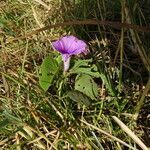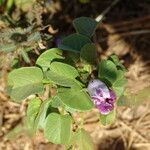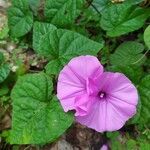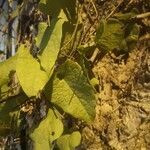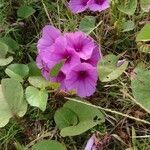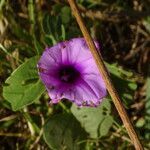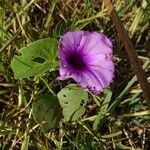Vines; stems herbaceous, decumbent and twining, rooting at the nodes gla-brous. Leaves rounded-cordate to subreniform, 4-8 cm long, basally cordate, apically rounded, glabrescent. Flowers solitary or in axillary or terminal simple or compound cymes, glabrous to puberulent; sepals unequal, the outer sepals 5-6 mm long, the inner sepals 10-12 mm long, elliptic to ovate, coriaceous, rounded apically, mucronate, glabrous; corolla lavender to purple, 6-8 cm long, funnelform. Fruits tardily dehiscent capsules, subglobose, 10-12 mm long, brown, glabrous; seeds brown to dark brown 6-7 mm long, minutely gray-pubescent.
Leaf lamina circular to reniform shaped, 3·5–7 × 3·5–8·5 cm., rounded at the apex, sometimes emarginate, mucronulate, cordate at the base with rounded lobes, glabrous, subcoriaceous; petiole 3–8·5 cm. long, rather thick with a deep longitudinal groove above, smooth or minutely muricated inflorescences axillary, often together with an axillary leaf shoot, cymosely 1-few-flowered; peduncle 2–5 cm. long; bracts ovate, minute; pedicels 1·5–3 cm. long.
Sepals unequal, all elliptic-oblong, obtuse, mucronulate; inner ones 811 mm. long; outer ones shorter, 5–8 mm. long, more or less muricate.
A twining herb. The stems are 4-6 mm across. The leaves are 12 cm long by 12 cm wide. They can be round or kidney shaped.
Corolla funnel-shaped, red-purple, up to 6·5 cm. long, glabrous.
Stems prostrate or sometimes twining, thick, terete or angular.
Perennial herb, much resembling I. pes-caprae (52).
A glabrous perennial, trailing; with hollow stems
Capsule globose, glabrous, as large as a pea.
Large red-purple flowers.
